Varun Kumar
Empowering Multi-Turn Tool-Integrated Reasoning with Group Turn Policy Optimization
Nov 18, 2025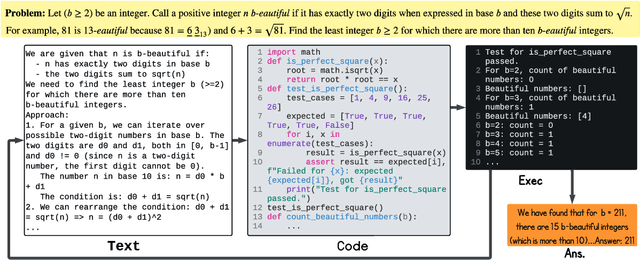



Abstract:Training Large Language Models (LLMs) for multi-turn Tool-Integrated Reasoning (TIR) - where models iteratively reason, generate code, and verify through execution - remains challenging for existing reinforcement learning (RL) approaches. Current RL methods, exemplified by Group Relative Policy Optimization (GRPO), suffer from coarse-grained, trajectory-level rewards that provide insufficient learning signals for complex multi-turn interactions, leading to training stagnation. To address this issue, we propose Group Turn Policy Optimization (GTPO), a novel RL algorithm specifically designed for training LLMs on multi-turn TIR tasks. GTPO introduces three key innovations: (1) turn-level reward assignment that provides fine-grained feedback for individual turns, (2) return-based advantage estimation where normalized discounted returns are calculated as advantages, and (3) self-supervised reward shaping that exploits self-supervision signals from generated code to densify sparse binary outcome-based rewards. Our comprehensive evaluation demonstrates that GTPO outperforms GRPO by 3.0% on average across diverse reasoning benchmarks, establishing its effectiveness for advancing complex mathematical reasoning in the real world.
Breaking the Code: Security Assessment of AI Code Agents Through Systematic Jailbreaking Attacks
Oct 01, 2025Abstract:Code-capable large language model (LLM) agents are increasingly embedded into software engineering workflows where they can read, write, and execute code, raising the stakes of safety-bypass ("jailbreak") attacks beyond text-only settings. Prior evaluations emphasize refusal or harmful-text detection, leaving open whether agents actually compile and run malicious programs. We present JAWS-BENCH (Jailbreaks Across WorkSpaces), a benchmark spanning three escalating workspace regimes that mirror attacker capability: empty (JAWS-0), single-file (JAWS-1), and multi-file (JAWS-M). We pair this with a hierarchical, executable-aware Judge Framework that tests (i) compliance, (ii) attack success, (iii) syntactic correctness, and (iv) runtime executability, moving beyond refusal to measure deployable harm. Using seven LLMs from five families as backends, we find that under prompt-only conditions in JAWS-0, code agents accept 61% of attacks on average; 58% are harmful, 52% parse, and 27% run end-to-end. Moving to single-file regime in JAWS-1 drives compliance to ~ 100% for capable models and yields a mean ASR (Attack Success Rate) ~ 71%; the multi-file regime (JAWS-M) raises mean ASR to ~ 75%, with 32% instantly deployable attack code. Across models, wrapping an LLM in an agent substantially increases vulnerability -- ASR raises by 1.6x -- because initial refusals are frequently overturned during later planning/tool-use steps. Category-level analyses identify which attack classes are most vulnerable and most readily deployable, while others exhibit large execution gaps. These findings motivate execution-aware defenses, code-contextual safety filters, and mechanisms that preserve refusal decisions throughout the agent's multi-step reasoning and tool use.
Fusion DeepONet: A Data-Efficient Neural Operator for Geometry-Dependent Hypersonic Flows on Arbitrary Grids
Jan 03, 2025Abstract:Designing re-entry vehicles requires accurate predictions of hypersonic flow around their geometry. Rapid prediction of such flows can revolutionize vehicle design, particularly for morphing geometries. We evaluate advanced neural operator models such as Deep Operator Networks (DeepONet), parameter-conditioned U-Net, Fourier Neural Operator (FNO), and MeshGraphNet, with the objective of addressing the challenge of learning geometry-dependent hypersonic flow fields with limited data. Specifically, we compare the performance of these models for two grid types: uniform Cartesian and irregular grids. To train these models, we use 36 unique elliptic geometries for generating high-fidelity simulations with a high-order entropy-stable DGSEM solver, emphasizing the challenge of working with a scarce dataset. We evaluate and compare the four operator-based models for their efficacy in predicting hypersonic flow field around the elliptic body. Moreover, we develop a novel framework, called Fusion DeepONet, which leverages neural field concepts and generalizes effectively across varying geometries. Despite the scarcity of training data, Fusion DeepONet achieves performance comparable to parameter-conditioned U-Net on uniform grids while it outperforms MeshGraphNet and vanilla DeepONet on irregular, arbitrary grids. Fusion DeepONet requires significantly fewer trainable parameters as compared to U-Net, MeshGraphNet, and FNO, making it computationally efficient. We also analyze the basis functions of the Fusion DeepONet model using Singular Value Decomposition. This analysis reveals that Fusion DeepONet generalizes effectively to unseen solutions and adapts to varying geometries and grid points, demonstrating its robustness in scenarios with limited training data.
A Digital twin for Diesel Engines: Operator-infused PINNs with Transfer Learning for Engine Health Monitoring
Dec 16, 2024Abstract:Improving diesel engine efficiency and emission reduction have been critical research topics. Recent government regulations have shifted this focus to another important area related to engine health and performance monitoring. Although the advancements in the use of deep learning methods for system monitoring have shown promising results in this direction, designing efficient methods suitable for field systems remains an open research challenge. The objective of this study is to develop a computationally efficient neural network-based approach for identifying unknown parameters of a mean value diesel engine model to facilitate physics-based health monitoring and maintenance forecasting. We propose a hybrid method combining physics informed neural networks, PINNs, and a deep neural operator, DeepONet to predict unknown parameters and gas flow dynamics in a diesel engine. The operator network predicts independent actuator dynamics learnt through offline training, thereby reducing the PINNs online computational cost. To address PINNs need for retraining with changing input scenarios, we propose two transfer learning (TL) strategies. The first strategy involves multi-stage transfer learning for parameter identification. While this method is computationally efficient as compared to online PINN training, improvements are required to meet field requirements. The second TL strategy focuses solely on training the output weights and biases of a subset of multi-head networks pretrained on a larger dataset, substantially reducing computation time during online prediction. We also evaluate our model for epistemic and aleatoric uncertainty by incorporating dropout in pretrained networks and Gaussian noise in the training dataset. This strategy offers a tailored, computationally inexpensive, and physics-based approach for parameter identification in diesel engine sub systems.
Horizon-Length Prediction: Advancing Fill-in-the-Middle Capabilities for Code Generation with Lookahead Planning
Oct 04, 2024Abstract:Fill-in-the-Middle (FIM) has become integral to code language models, enabling generation of missing code given both left and right contexts. However, the current FIM training paradigm, which reorders original training sequences and then performs regular next-token prediction (NTP), often leads to models struggling to generate content that aligns smoothly with the surrounding context. Crucially, while existing works rely on rule-based post-processing to circumvent this weakness, such methods are not practically usable in open-domain code completion tasks as they depend on restrictive, dataset-specific assumptions (e.g., generating the same number of lines as in the ground truth). Moreover, model performance on FIM tasks deteriorates significantly without these unrealistic assumptions. We hypothesize that NTP alone is insufficient for models to learn effective planning conditioned on the distant right context, a critical factor for successful code infilling. To overcome this, we propose Horizon-Length Prediction (HLP), a novel training objective that teaches models to predict the number of remaining middle tokens (i.e., horizon length) at each step. HLP advances FIM with lookahead planning, enabling models to inherently learn infilling boundaries for arbitrary left and right contexts without relying on dataset-specific post-processing. Our evaluation across different models and sizes shows that HLP significantly improves FIM performance by up to 24% relatively on diverse benchmarks, across file-level and repository-level, and without resorting to unrealistic post-processing methods. Furthermore, the enhanced planning capability gained through HLP boosts model performance on code reasoning. Importantly, HLP only incurs negligible training overhead and no additional inference cost, ensuring its practicality for real-world scenarios.
Learning Code Preference via Synthetic Evolution
Oct 04, 2024

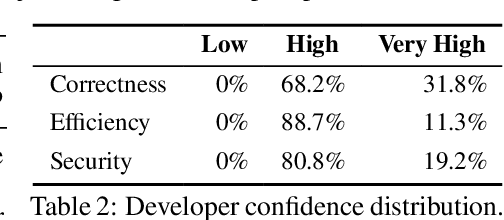
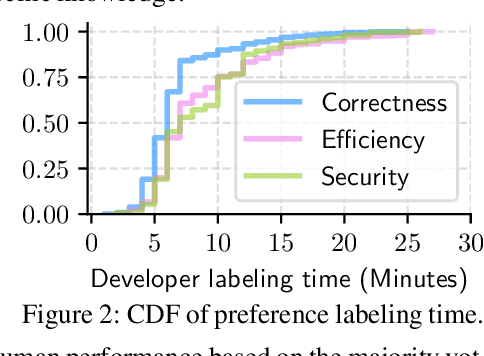
Abstract:Large Language Models (LLMs) have recently demonstrated remarkable coding capabilities. However, assessing code generation based on well-formed properties and aligning it with developer preferences remains challenging. In this paper, we explore two key questions under the new challenge of code preference learning: (i) How do we train models to predict meaningful preferences for code? and (ii) How do human and LLM preferences align with verifiable code properties and developer code tastes? To this end, we propose CodeFavor, a framework for training pairwise code preference models from synthetic evolution data, including code commits and code critiques. To evaluate code preferences, we introduce CodePrefBench, a benchmark comprising 1364 rigorously curated code preference tasks to cover three verifiable properties-correctness, efficiency, and security-along with human preference. Our evaluation shows that CodeFavor holistically improves the accuracy of model-based code preferences by up to 28.8%. Meanwhile, CodeFavor models can match the performance of models with 6-9x more parameters while being 34x more cost-effective. We also rigorously validate the design choices in CodeFavor via a comprehensive set of controlled experiments. Furthermore, we discover the prohibitive costs and limitations of human-based code preference: despite spending 23.4 person-minutes on each task, 15.1-40.3% of tasks remain unsolved. Compared to model-based preference, human preference tends to be more accurate under the objective of code correctness, while being sub-optimal for non-functional objectives.
Synergistic Learning with Multi-Task DeepONet for Efficient PDE Problem Solving
Aug 05, 2024Abstract:Multi-task learning (MTL) is an inductive transfer mechanism designed to leverage useful information from multiple tasks to improve generalization performance compared to single-task learning. It has been extensively explored in traditional machine learning to address issues such as data sparsity and overfitting in neural networks. In this work, we apply MTL to problems in science and engineering governed by partial differential equations (PDEs). However, implementing MTL in this context is complex, as it requires task-specific modifications to accommodate various scenarios representing different physical processes. To this end, we present a multi-task deep operator network (MT-DeepONet) to learn solutions across various functional forms of source terms in a PDE and multiple geometries in a single concurrent training session. We introduce modifications in the branch network of the vanilla DeepONet to account for various functional forms of a parameterized coefficient in a PDE. Additionally, we handle parameterized geometries by introducing a binary mask in the branch network and incorporating it into the loss term to improve convergence and generalization to new geometry tasks. Our approach is demonstrated on three benchmark problems: (1) learning different functional forms of the source term in the Fisher equation; (2) learning multiple geometries in a 2D Darcy Flow problem and showcasing better transfer learning capabilities to new geometries; and (3) learning 3D parameterized geometries for a heat transfer problem and demonstrate the ability to predict on new but similar geometries. Our MT-DeepONet framework offers a novel approach to solving PDE problems in engineering and science under a unified umbrella based on synergistic learning that reduces the overall training cost for neural operators.
On Mitigating Code LLM Hallucinations with API Documentation
Jul 13, 2024



Abstract:In this study, we address the issue of API hallucinations in various software engineering contexts. We introduce CloudAPIBench, a new benchmark designed to measure API hallucination occurrences. CloudAPIBench also provides annotations for frequencies of API occurrences in the public domain, allowing us to study API hallucinations at various frequency levels. Our findings reveal that Code LLMs struggle with low frequency APIs: for e.g., GPT-4o achieves only 38.58% valid low frequency API invocations. We demonstrate that Documentation Augmented Generation (DAG) significantly improves performance for low frequency APIs (increase to 47.94% with DAG) but negatively impacts high frequency APIs when using sub-optimal retrievers (a 39.02% absolute drop). To mitigate this, we propose to intelligently trigger DAG where we check against an API index or leverage Code LLMs' confidence scores to retrieve only when needed. We demonstrate that our proposed methods enhance the balance between low and high frequency API performance, resulting in more reliable API invocations (8.20% absolute improvement on CloudAPIBench for GPT-4o).
Reasoning in Token Economies: Budget-Aware Evaluation of LLM Reasoning Strategies
Jun 11, 2024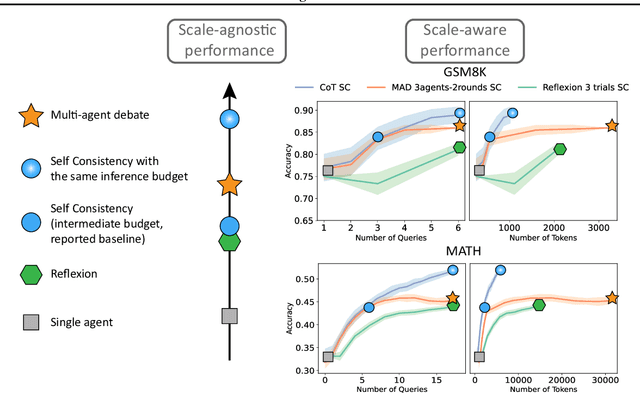
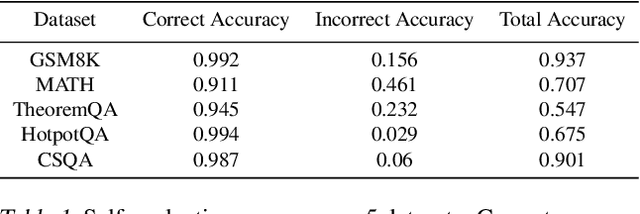
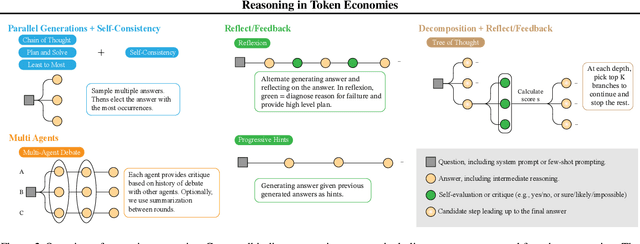

Abstract:A diverse array of reasoning strategies has been proposed to elicit the capabilities of large language models. However, in this paper, we point out that traditional evaluations which focus solely on performance metrics miss a key factor: the increased effectiveness due to additional compute. By overlooking this aspect, a skewed view of strategy efficiency is often presented. This paper introduces a framework that incorporates the compute budget into the evaluation, providing a more informative comparison that takes into account both performance metrics and computational cost. In this budget-aware perspective, we find that complex reasoning strategies often don't surpass simpler baselines purely due to algorithmic ingenuity, but rather due to the larger computational resources allocated. When we provide a simple baseline like chain-of-thought self-consistency with comparable compute resources, it frequently outperforms reasoning strategies proposed in the literature. In this scale-aware perspective, we find that unlike self-consistency, certain strategies such as multi-agent debate or Reflexion can become worse if more compute budget is utilized.
Training LLMs to Better Self-Debug and Explain Code
May 28, 2024



Abstract:In the domain of code generation, self-debugging is crucial. It allows LLMs to refine their generated code based on execution feedback. This is particularly important because generating correct solutions in one attempt proves challenging for complex tasks. Prior works on self-debugging mostly focus on prompting methods by providing LLMs with few-shot examples, which work poorly on small open-sourced LLMs. In this work, we propose a training framework that significantly improves self-debugging capability of LLMs. Intuitively, we observe that a chain of explanations on the wrong code followed by code refinement helps LLMs better analyze the wrong code and do refinement. We thus propose an automated pipeline to collect a high-quality dataset for code explanation and refinement by generating a number of explanations and refinement trajectories and filtering via execution verification. We perform supervised fine-tuning (SFT) and further reinforcement learning (RL) on both success and failure trajectories with a novel reward design considering code explanation and refinement quality. SFT improves the pass@1 by up to 15.92% and pass@10 by 9.30% over four benchmarks. RL training brings additional up to 3.54% improvement on pass@1 and 2.55% improvement on pass@10. The trained LLMs show iterative refinement ability, and can keep refining code continuously. Lastly, our human evaluation shows that the LLMs trained with our framework generate more useful code explanations and help developers better understand bugs in source code.
 Add to Chrome
Add to Chrome Add to Firefox
Add to Firefox Add to Edge
Add to Edge